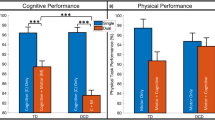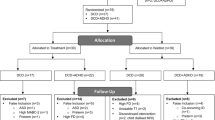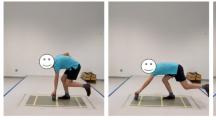Abstract
Background
The aim of this study was to understand the challenges experienced by families obtaining a diagnosis and therapy for developmental coordination disorder (DCD).
Methods
Parents of 435 children aged 4–18 years with persistent motor difficulties consistent with a diagnosis of DCD completed an online survey. Diagnostic timeline and diagnostic label/s received were examined, along with therapies accessed.
Results
There was inconsistent diagnostic terminology (nine separate terms) with more children diagnosed with dyspraxia (64.7%) than DCD (48.8%). Even though most parents (87.0%) reported that receiving a diagnosis was helpful, children did not receive a diagnosis until years after seeking help (mean 2.8 ± 2.3 years). Many children were diagnosed with at least one co-occurring neurodevelopmental, language or learning disorder (70.0%). Almost all families had accessed therapy for their child’s movement difficulties (93.9%), but more than half did not have access to funding to support therapy costs (57.8%) and reported that the costs caused financial strain (52.6%). Two out of every three families reported that they did not feel the current level of therapy was sufficient.
Conclusions
This critical advocacy research highlights inconsistent and incorrect terminology and the challenges families experience in obtaining a diagnosis and adequate access to therapy for their child’s movement difficulties.
Impact
-
This is the first comprehensive study to examine the challenges families experience gaining a diagnosis and therapy for their child with DCD.
-
Families regularly experienced prolonged diagnosis; 45% waited between 2 and 4 years.
-
There is no clear diagnostic pathway, with children more likely to be diagnosed with dyspraxia than the correct clinical diagnosis of DCD.
-
More extensive implementation of the diagnostic guidelines into clinical practice is needed.
Similar content being viewed by others
Log in or create a free account to read this content
Gain free access to this article, as well as selected content from this journal and more on nature.com
or
References
American Psychiatric Association. Diagnostic and Statistical Manual of Mental Disorders: DSM 5 (American Psychiatric Association, 2013).
American Psychiatric Association. Diagnostic and Statistical Manual of Mental Disorders: DSM-IV (American Psychiatric Association, 1994).
American Psychiatric Association. Diagnostic and Statistical Manual of Mental Disorders: DSM-III-R (American Psychiatric Association, 1987).
World Health Organization. The ICD-11 International Statistical Classification of Diseases and Related Health Problems (World Health Organization, 2020).
World Health Organization. The ICD-10 Classification of Mental and Behavioral Disorders: Clinical Descriptions and Diagnostic Guidelines (World Health Organization, 1992).
Blank, R. et al. International clinical practice recommendations on the definition, diagnosis, assessment, intervention, and psychosocial aspects of developmental coordination disorder. Dev. Med. Child Neurol. 61, 242–285 (2019).
Schell, S., Roth, K. & Duchow, H. Developmental coordination disorder in Alberta: a journey into knowledge translation. Phys. Occup. Ther. Pediatr. 40, 294–310 (2020).
Gibbs, J., Appleton, J. & Appleton, R. Dyspraxia or developmental coordination disorder? Unravelling the enigma. Arch. Dis. Child. 92, 534–539 (2007).
Caçola, P. Physical and mental health of children with developmental coordination disorder. Front. Public Health 4, 224 (2016).
Karras, H. C., Morin, D. N., Gill, K., Izadi-Najafabadi, S. & Zwicker, J. G. Health-related quality of life of children with developmental coordination disorder. Res. Dev. Disabil. 84, 85–95 (2019).
Zwicker, J. G., Harris, S. R. & Klassen, A. F. Quality of life domains affected in children with developmental coordination disorder: a systematic review. Child Care Health Dev. 39, 562–580 (2013).
Zwicker, J. G., Suto, M., Harris, S. R., Vlasakova, N. & Missiuna, C. Developmental coordination disorder is more than a motor problem: children describe the impact of daily struggles on their quality of life. Br. J. Occup. Ther. 81, 65–73 (2018).
Licari, M. K. et al. Prevalence of motor difficulties in autism spectrum disorder: analysis of a population‐based cohort. Autism Res. 13, 298–306 (2020).
Kadesjö, B. & Gillberg, C. Attention deficits and clumsiness in Swedish 7‐year‐old children. Dev. Med. Child Neurol. 40, 796–804 (1998).
Rodger, S. & Mandich, A. Getting the run around: accessing services for children with developmental co-ordination disorder. Child Care Health Dev. 31, 449–457 (2005).
Wilson, B. N., Neil, K., Kamps, P. H. & Babcock, S. Awareness and knowledge of developmental co-ordination disorder among physicians, teachers and parents. Child Care Health Dev. 39, 296–300 (2013).
Hunt, J., Zwicker, J., Godecke, E. & Raynor, A. Awareness and knowledge of developmental coordination disorder: a survey of caregivers, teachers, allied health professionals and medical professionals in Australia. Child. Care Health Dev. (2020).
Henderson, S. E. & Henderson, L. Toward an understanding of developmental coordination disorder: terminological and diagnostic issues. Neural Plast. 10, 1–13 (2003).
Anderson-Mooney, A. J., Schmitt, F. A., Head, E., Lott, I. T. & Heilman, K. M. Gait dyspraxia as a clinical marker of cognitive decline in Down syndrome: a review of theory and proposed mechanisms. Brain Cogn. 104, 48–57 (2016).
Onder, H. Dyspraxic gait due to right posterior cerebral artery stroke. J. Neurosci. Rural Pract. 9, 162 (2018).
Kumar, A. & Tsao, J. W. Alzheimer disease. https://europepmc.org/article/NBK/NBK499922 (2019).
Yu, Y. T. et al. A psychometric study of the Bayley Scales of Infant and Toddler Development—3rd Edition for term and preterm Taiwanese infants. Res. Dev. Disabil. 34, 3875–3883 (2013).
Esmail, S. The diagnosis and management of Parkinson’s disease. Sch. J. Appl Sci. Res. 1, 13–19 (2018).
Karkling, M., Paul, A. & Zwicker, J. G. Occupational therapists’ awareness of guidelines for assessment and diagnosis of developmental coordination disorder: Mesure selon laquelle les ergothérapeutes connaissent les lignes directrices relatives à l’évaluation et au diagnostic du trouble du déve. Can. J. Occup. Ther. 84, 148–157 (2017).
Missiuna, C., Moll, S., Law, M., King, S. & King, G. Mysteries and mazes: parents’ experiences of children with developmental coordination disorder. Can. J. Occup. Ther. 73, 7–17 (2006).
Jijon, A. M. & Leonard, H. C. Parenting stress in parents of children with developmental coordination disorder. Res. Dev. Disabil. 104, 103695 (2020).
Licari, M. K. & Williams, J., Impact for DCD Team. National survey evaluating the impact of developmental coordination disorder in Australia: summary of results. https://www.telethonkids.org.au/globalassets/media/documents/projects/impact-for-dcd-report.pdf (2020).
Blank, R., Smith-Engelsman, B., Polatajko, H. & Wilson, P. European academy for childhood disability (EACD): recommendations on the definition, diagnosis and intervention of developmental coordination disorder (long version). Dev. Med. Child Neurol. 54, 54–93 (2012).
Green, D. et al. Impairment in movement skills of children with autistic spectrum disorders. Dev. Med. Child Neurol. 51, 311–316 (2009).
Pitcher, T. M., Piek, J. P. & Hay, D. A. Fine and gross motor ability in males with ADHD. Dev. Med. Child Neurol. 45, 525–535 (2003).
Ho, A. K. & Wilmut, K. Speech and oro-motor function in children with developmental coordination disorder: a pilot study. Hum. Mov. Sci. 29, 605–614 (2010).
Jenni, O. G., Chaouch, A., Caflisch, J. & Rousson, V. Infant motor milestones: poor predictive value for outcome of healthy children. Acta Paediatr. 102, e181–e184 (2013).
Missiuna, C., Moll, S., King, G., Stewart, D. & Macdonald, K. Life experiences of young adults who have coordination difficulties. Can. J. Occup. Ther. 75, 157–166 (2008).
Novak, I. & Honan, I. Effectiveness of paediatric occupational therapy for children with disabilities: a systematic review. Aust. Occup. Ther. J. 66, 258–273 (2019).
Acknowledgements
We are grateful to the families who participated in this study. We acknowledge the contribution made to this project by DCD Australia Incorporated, the national peak body supporting people with DCD and their families in Australia. We would also like to thank the individuals and health services across Australia that helped to develop and promote the survey.
Author information
Authors and Affiliations
Contributions
M.K.L. and J.W. conceptualised and designed the study, with feedback on the design received from C.B., C.E., S.L.R. and A.J.S. Data acquisition and analysis were overseen by M.K.L. and J.W. All authors contributed to the interpretation of results. Drafting of the article was performed with by M.K.L., with all authors revising it critically for important intellectual content. All authors approved the final version of this article for publication.
Corresponding author
Ethics declarations
Competing interests
The authors declare no competing interests.
Statement of consent
All participants gave informed consent.
Additional information
Publisher’s note Springer Nature remains neutral with regard to jurisdictional claims in published maps and institutional affiliations.
Rights and permissions
About this article
Cite this article
Licari, M.K., Alvares, G.A., Bernie, C. et al. The unmet clinical needs of children with developmental coordination disorder. Pediatr Res 90, 826–831 (2021). https://doi.org/10.1038/s41390-021-01373-1
Received:
Revised:
Accepted:
Published:
Issue date:
DOI: https://doi.org/10.1038/s41390-021-01373-1
This article is cited by
-
Hidden in Plain Sight: Early Signs of Developmental Coordination Disorder
Current Developmental Disorders Reports (2025)
-
Low Motor Competence or Developmental Coordination Disorder? An Overview and Framework to Understand Motor Difficulties in Children
Current Developmental Disorders Reports (2024)



